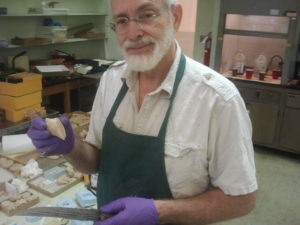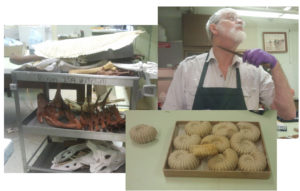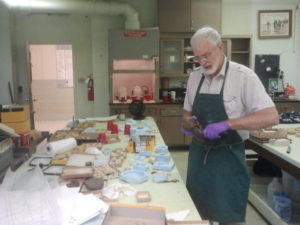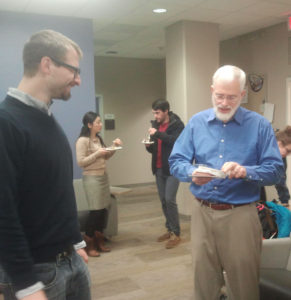Over 200 million years ago, a reptile, 11 feet long and 1500 pounds, was prowling about, likely feeling very pleased with himself. Not only did he have four crunchy creatures starting to digest in his stomach, but he had bitten another weakling in the neck and then crushed it under his left knee. Just at this moment of triumph, the reptile got stuck in the mud of ancient Jordan Lake, and slowly drowned.
Around the same time, by the seaside of what would one day become Italy, the forerunners to today’s oyster were nestling on the sea floor.
41 years ago, in 1976, Dr. Joe Carter obtained his PhD from Yale University and then drove down with his wife to start a new job at Chapel Hill’s geology department. He came as a sleuth for fossils. Ancient oysters, clams, mollusks, bivalves – Dr. Carter wanted to learn as much about them as he could.

For most of us, shells are just the violet-tinted, half-moon shaped spectacles that nip our feet at the beach.
But for Dr. Carter, these bivalves – and especially their fossils resurrected millions of years after they lived – are clues into evolutionary history.
In 1980, Dr. Carter took a trip to the mountains of northeastern Italy. There, he found an 80-year-old man who had been collecting Triassic fossils for decades – bivalves that lived 200 to 250 million years ago. The prospect of so many fossils was like coming upon a casket of jewels for Dr. Carter. The Italian man gave him a generous sampling of his fossil collection, and Dr. Carter fell to examining them.
“Well, this looks like an oyster,” Dr. Carter speculated, as he dwelt upon one of his fossils. Or was it? Oyster fossils dated back in time for 200 million years, beyond which they disappeared into the guarded slumber of the unwritten past. Scientists had assumed this marked the juncture at which oysters evolved, and as they cast about for a suitable ancestor, they decided upon scallops: both oysters and scallops have similar, non-pearly shells.
But perhaps the little Italian oyster told a whole new story. To investigate, Dr. Carter participated in a blatant case of disturbing the peace of the deceased. He took his Italian bivalve, sharpened his knife, and embarked on a long-delayed autopsy.
He dissected the defenseless fossil into impossibly tiny 150 micrometer slices. He examined each slice carefully under a microscope, then enlarged them on plastic drafting paper. Then, he had a “eureka” moment.
Today’s oysters are almost all calcite and non-pearly. But Dr. Carter’s ancient Triassic oyster had only a hint of calcite and it consisted mostly of mother-of-pearl. Could the mother-of-pearl oyster indicate that oysters evolved from “pearl oysters”, rather than from scallops?

It was time to see if DNA could confirm the hint provided by the fossil record, a task given to Dr. Carter’s student, Kateri Hoekstra. She performed one of the first DNA analyses of living bivalves ever to focus on their evolutionary relationships. Just as the fossil record predicted, the DNA confirmed that the oyster from the Italian mountains, dug up after its rest of 221 million years, was a closer relative of pearl oysters than scallops.
Dr. Carter sent a letter to many natural history museums in Italy, asking them to find more of the mother-of-pearl oyster. But no one ever did. Still, Dr. Carter had fine pictures and drawings of the single known fossil. People started citing the fossil as UNC-13497b.
Such a clunky name would never do for the only mother-of-pearl oyster in the world, even if it did honor our great university. Dr. Carter finally christened it Nacrolopha carolae: Nacrolopha after the nacre (mother-of-pearl) in the Lopha-like oyster, and carolae after his wife, Carol Elizabeth.
This is the sweet side of invertebrate paleontology: a fine day in the Italian mountains, mother-of-pearl oysters, and suffusing the faint echoes of history with the name of your loved one.
But not everyone wants to give fossils their due attention.
The fossil record isn’t always perfect. For example, jellyfish rarely even leave fossils. For snails, the fossil record is misleading due to convergent evolution. The same features evolved in so many different snails that it’s hard to put things in order. You see the same shapes come up again and again.
As a result, many biologists have decided to send the fossil record packing. Since it doesn’t enlighten relationships for all groups of species, the idea that it might provide clues for a few is uncharted territory.
On the other side of the line-up, you have a handful of scientists, Dr. Carter, his former students, and his research colleagues among them. They are trying to convince the biologists that for some groups of species – especially bivalves – the fossil record is actually crucial.
It’s an uphill battle because, as Dr. Carter explains, the biologists have all the money. They are awash with government funds through the “Tree of Life” project that puts primary emphasis on DNA linkages between species.

Dr. Carter recognizes that DNA is a necessary tool. After all, it was Kateri’s DNA analysis that confirmed the origination of Nacrolopha carolae and modern oysters from pearl oysters. But it’s not the whole story. For example, DNA tells us that our closest relatives are the chimps. But that does not mean we evolved from them, or them from us! Fossils are the missing key that can shed light on the extinct creatures who filled in the evolutionary gaps.
Dr. Carter, along with David Campbell, his former student, now a professor at Gardner-Webb University, published a paper where they described how DNA and the fossil record can be used in symphony. Unfortunately, as Dr. Carter explains, “lots of people thought it was baloney.”
That reception is not stopping Dr. Carter. He and David Campbell are trying to publish a series of papers with examples of how DNA can give faulty evidence that the fossil record can correct. As Dr. Carter says, it will be interesting to see what the opposition says at that point.
Opposition aside, there’s one set of fossils that dazzles everyone – those of dinosaurs. Dr. Carter’s one foray into reptilian fossils happened by accident. Two of his students were studying a Durham quarry in 1994, when they came across the ankle bones of “a weird new guy”. It was the same unfortunate creature that, having filled his stomach with four prey, sank into a mudhole of ancient Jordan Lake and drowned just at its very moment of triumph. Digging it up, Dr. Carter and his students found hundreds of bones. Once cleaned and reassembled, it turned out to be a reptile shaped very much like a dinosaur, but not quite.
Dinosaurs roamed about on tiptoe, but this reptile’s foot walked on both toes and heels, like humans do. It was the best-preserved skeleton of this group of reptiles ever found. Dr. Carter toured museums in Europe and the US to make sure the reptile had not been named before.
Just thereafter, Karin Peyer walked into Dr. Carter’s office. She had an undergraduate degree in paleontology, a husband starting graduate school at UNC, and time on her hands. She asked: do you need any help?
“Boy, did you come at the right time!” Dr. Carter greeted her. Karin worked with Dr. Carter and experts from the Smithsonian Institution to formally describe and name the find.
They called it Postosuchus alisonae – alisonae a tribute to a friend of Dr. Carter’s who was dying of cancer at that time.
*******************
It was December 2015. In Dr. Carter’s large dim lab, filmy sheets of plastic drafting paper were ruffling in a soft breeze from the open window looking out on a hillside over Columbia Street. Sickle-shaped knives were stacked here and there, beside replicas of treasure from King Tut’s tomb. In between sectioning and sketching an ancient bivalve called Modiolopsis, Dr. Carter was packing.

He was retiring after 39 years. In practice, that merely means that Dr. Carter can now avoid going to faculty meetings. Otherwise, he can still serve on graduate student committees; he is coordinating the revisions of bivalves in the Treatise of Invertebrate Paleontology. He still has fossils to section and examine, and biologists to convince of the worth of the fossil record.
The only difference is, when Dr. Carter began his professorial work, it was just him and his wife, a young daughter and a baby boy. Now his daughter is 45 years old and his son is 39, and they both have their own families that Dr. Carter will be spending a lot of time with. It’s amazing what changes four decades can bring. But perhaps it’s easier to be philosophical and surrender to what’s ahead when you hold in your hands an oyster that lived 221 million years ago.
Peer edited by Lindsay Walton and Alison Earley.
Follow us on social media and never miss an article:
What a great article about my cousin.
Nancy McCann
Thank you!